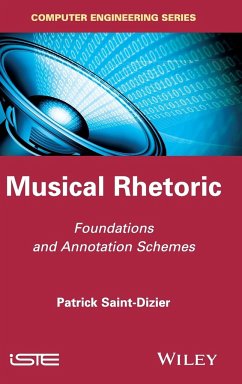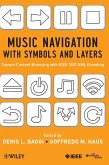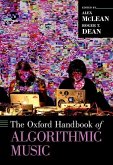- Gebundenes Buch
- Merkliste
- Auf die Merkliste
- Bewerten Bewerten
- Teilen
- Produkt teilen
- Produkterinnerung
- Produkterinnerung
Discourse analysis and rhetoric are very much developed in communication, linguistics, cognitive science and artificial intelligence. Besides theoretical investigations, discourse analysis is central in a number of application areas such as dialogue and negotiation, the semantic web, question answering or authoring systems. Music is also a natural language, more abstract and mathematical, which follows very strict construction principles. However, there is very limited and no recent literature on Music Discourse analysis using computational principles. This book aims at developing a central…mehr
Andere Kunden interessierten sich auch für
![Musical Sound Effects Musical Sound Effects]() Jean-Michel RéveillacMusical Sound Effects187,99 €
Jean-Michel RéveillacMusical Sound Effects187,99 €![Music Navigation Music Navigation]() Denis L BaggiMusic Navigation114,99 €
Denis L BaggiMusic Navigation114,99 €![The Oxford Handbook of Algorithmic Music The Oxford Handbook of Algorithmic Music]() The Oxford Handbook of Algorithmic Music223,99 €
The Oxford Handbook of Algorithmic Music223,99 €![Mixing with Impact Mixing with Impact]() Wessel OlthetenMixing with Impact239,99 €
Wessel OlthetenMixing with Impact239,99 €![Acoustic Particle Velocity Measurements Using Lasers Acoustic Particle Velocity Measurements Using Lasers]() Jean-Christophe ValièreAcoustic Particle Velocity Measurements Using Lasers187,99 €
Jean-Christophe ValièreAcoustic Particle Velocity Measurements Using Lasers187,99 €![UHF RFID Technologies for Identification and Traceability UHF RFID Technologies for Identification and Traceability]() Jean-Marc LaheurteUHF RFID Technologies for Identification and Traceability186,99 €
Jean-Marc LaheurteUHF RFID Technologies for Identification and Traceability186,99 €![Mathematical Foundations of Image Processing and Analysis, Volume 2 Mathematical Foundations of Image Processing and Analysis, Volume 2]() Jean-Charles PinoliMathematical Foundations of Image Processing and Analysis, Volume 2237,99 €
Jean-Charles PinoliMathematical Foundations of Image Processing and Analysis, Volume 2237,99 €-
-
-
Discourse analysis and rhetoric are very much developed in communication, linguistics, cognitive science and artificial intelligence. Besides theoretical investigations, discourse analysis is central in a number of application areas such as dialogue and negotiation, the semantic web, question answering or authoring systems. Music is also a natural language, more abstract and mathematical, which follows very strict construction principles. However, there is very limited and no recent literature on Music Discourse analysis using computational principles. This book aims at developing a central issue in musical discourse: modeling rhetoric and argumentation. It also contributes to the development of high-level multimedia annotation schemes for non-verbal communication.
Hinweis: Dieser Artikel kann nur an eine deutsche Lieferadresse ausgeliefert werden.
Hinweis: Dieser Artikel kann nur an eine deutsche Lieferadresse ausgeliefert werden.
Produktdetails
- Produktdetails
- Verlag: Wiley
- Seitenzahl: 208
- Erscheinungstermin: 6. Oktober 2014
- Englisch
- Abmessung: 240mm x 161mm x 16mm
- Gewicht: 478g
- ISBN-13: 9781848215610
- ISBN-10: 1848215614
- Artikelnr.: 40814754
- Herstellerkennzeichnung
- Libri GmbH
- Europaallee 1
- 36244 Bad Hersfeld
- gpsr@libri.de
- Verlag: Wiley
- Seitenzahl: 208
- Erscheinungstermin: 6. Oktober 2014
- Englisch
- Abmessung: 240mm x 161mm x 16mm
- Gewicht: 478g
- ISBN-13: 9781848215610
- ISBN-10: 1848215614
- Artikelnr.: 40814754
- Herstellerkennzeichnung
- Libri GmbH
- Europaallee 1
- 36244 Bad Hersfeld
- gpsr@libri.de
Patrick Saint-Dizier, Senior researcher at CNRS, Toulouse, France.
PREFACE xi
CHAPTER 1. AN INTRODUCTION TO CLASSICAL RHETORIC 1
1.1. A few basic definitions 2
1.2. The structure of rhetoric 4
1.2.1. Rhetoric and communication 5
1.2.2. The structure of classical rhetoric 6
1.2.3. The invention step 7
1.2.4. The arrangement 9
1.2.5. The style or elocution step 12
1.2.6. The delivery or action 14
1.2.7. The facets of rhetoric 15
1.3. Some figures of speech 17
1.3.1. Introduction 17
1.3.2. The major figures of speech of interest in music rhetoric 18
1.4. Argumentation and explanation 21
1.5. Conclusion: a few historical milestones of traditional rhetoric 25
1.6. A few historical references for classical rhetoric 28
CHAPTER 2. LANGUAGE, MUSIC AND THE RHETORIC DISCOURSE 31
2.1. Music and language 31
2.1.1. On the relations between language and music 32
2.1.2. Going into the details of music parameters, music for rhetoric 36
2.1.3. Music and rhetoric 42
2.2. A few historical milestones of music rhetoric emergence and evolution
43
2.2.1. The Middle Ages and the Renaissance 44
2.2.2. The transition between the Renaissance and the Baroque period 48
2.2.3. The Baroque period 51
2.2.4. The Classical period 54
2.2.5. The Romantic period 56
2.3. Main contemporary trends in music rhetoric 58
CHAPTER 3. THE SYMBOLISM OF MUSICAL ELEMENTS 61
3.1. Symbolic and perceptual properties of modes and tonalities 62
3.2. Perceptual and symbolic properties of intervals 65
3.3. Musical figures and their role in rhetoric 67
3.4. Figures of rhythm and their roles in rhetoric 74
3.5. Motive alternations 79
3.6. Figures of counterpoint 80
3.7. The symbolism of numbers and proportions 83
3.8. The rhetoric contents of classical forms 87
3.8.1. The perception of large forms 87
3.8.2. The simple bi- and tripartite forms 88
3.8.3. The sonata forms 95
3.9. Conclusion 98
CHAPTER 4. FEATURE STRUCTURES FOR REPRESENTING MUSICAL CONSTRUCTIONS 101
4.1. Feature structures in language 102
4.2. Representation of a melody by a feature structure 104
4.3. From musical motives to polyphony 109
4.4. Dealing with harmony 110
4.5. A few generic operations of feature structures 112
4.5.1. Transformations by augmentation or diminution 112
4.5.2. Mirror forms 114
4.5.3. Reverse forms 116
4.5.4. A few other transformations 117
4.5.5. Expressive power of this formalism 117
4.6. Elements of annotation of musical structures in XML 118
4.6.1. Basic feature structures 118
4.6.2. Advanced XML annotations for two-dimension structures 120
4.6.3. Figures of sound in XML 121
4.7. Perspectives 125
CHAPTER 5. A RHETORIC ANALYSIS OF MUSICAL WORKS 127
5.1. Discourse theories in linguistics 128
5.1.1. The rhetorical structure theory 129
5.1.2. The pragma-dialectic movement 131
5.2. The rhetoric of the stylus phantasticus 132
5.3. The rhetoric and argumentation dimensions of J.S. Bach's C. minor
Passacaglia 140
5.3.1. The global structure and the symbolic of numbers 140
5.3.2. The structure of the argumentation in the Passacaglia 142
5.4. The dialectics of the personality split 147
5.5. Beethoven's Muss es sein? Question and debate 149
5.5.1. The personal context 149
5.5.2. The questions and their formulations 150
5.5.3. The response formulations 155
5.6. A high-level notation for the structure of musical works 161
5.7. Conclusion 166
BIBLIOGRAPHY 167
INDEX 177
CHAPTER 1. AN INTRODUCTION TO CLASSICAL RHETORIC 1
1.1. A few basic definitions 2
1.2. The structure of rhetoric 4
1.2.1. Rhetoric and communication 5
1.2.2. The structure of classical rhetoric 6
1.2.3. The invention step 7
1.2.4. The arrangement 9
1.2.5. The style or elocution step 12
1.2.6. The delivery or action 14
1.2.7. The facets of rhetoric 15
1.3. Some figures of speech 17
1.3.1. Introduction 17
1.3.2. The major figures of speech of interest in music rhetoric 18
1.4. Argumentation and explanation 21
1.5. Conclusion: a few historical milestones of traditional rhetoric 25
1.6. A few historical references for classical rhetoric 28
CHAPTER 2. LANGUAGE, MUSIC AND THE RHETORIC DISCOURSE 31
2.1. Music and language 31
2.1.1. On the relations between language and music 32
2.1.2. Going into the details of music parameters, music for rhetoric 36
2.1.3. Music and rhetoric 42
2.2. A few historical milestones of music rhetoric emergence and evolution
43
2.2.1. The Middle Ages and the Renaissance 44
2.2.2. The transition between the Renaissance and the Baroque period 48
2.2.3. The Baroque period 51
2.2.4. The Classical period 54
2.2.5. The Romantic period 56
2.3. Main contemporary trends in music rhetoric 58
CHAPTER 3. THE SYMBOLISM OF MUSICAL ELEMENTS 61
3.1. Symbolic and perceptual properties of modes and tonalities 62
3.2. Perceptual and symbolic properties of intervals 65
3.3. Musical figures and their role in rhetoric 67
3.4. Figures of rhythm and their roles in rhetoric 74
3.5. Motive alternations 79
3.6. Figures of counterpoint 80
3.7. The symbolism of numbers and proportions 83
3.8. The rhetoric contents of classical forms 87
3.8.1. The perception of large forms 87
3.8.2. The simple bi- and tripartite forms 88
3.8.3. The sonata forms 95
3.9. Conclusion 98
CHAPTER 4. FEATURE STRUCTURES FOR REPRESENTING MUSICAL CONSTRUCTIONS 101
4.1. Feature structures in language 102
4.2. Representation of a melody by a feature structure 104
4.3. From musical motives to polyphony 109
4.4. Dealing with harmony 110
4.5. A few generic operations of feature structures 112
4.5.1. Transformations by augmentation or diminution 112
4.5.2. Mirror forms 114
4.5.3. Reverse forms 116
4.5.4. A few other transformations 117
4.5.5. Expressive power of this formalism 117
4.6. Elements of annotation of musical structures in XML 118
4.6.1. Basic feature structures 118
4.6.2. Advanced XML annotations for two-dimension structures 120
4.6.3. Figures of sound in XML 121
4.7. Perspectives 125
CHAPTER 5. A RHETORIC ANALYSIS OF MUSICAL WORKS 127
5.1. Discourse theories in linguistics 128
5.1.1. The rhetorical structure theory 129
5.1.2. The pragma-dialectic movement 131
5.2. The rhetoric of the stylus phantasticus 132
5.3. The rhetoric and argumentation dimensions of J.S. Bach's C. minor
Passacaglia 140
5.3.1. The global structure and the symbolic of numbers 140
5.3.2. The structure of the argumentation in the Passacaglia 142
5.4. The dialectics of the personality split 147
5.5. Beethoven's Muss es sein? Question and debate 149
5.5.1. The personal context 149
5.5.2. The questions and their formulations 150
5.5.3. The response formulations 155
5.6. A high-level notation for the structure of musical works 161
5.7. Conclusion 166
BIBLIOGRAPHY 167
INDEX 177
PREFACE xi
CHAPTER 1. AN INTRODUCTION TO CLASSICAL RHETORIC 1
1.1. A few basic definitions 2
1.2. The structure of rhetoric 4
1.2.1. Rhetoric and communication 5
1.2.2. The structure of classical rhetoric 6
1.2.3. The invention step 7
1.2.4. The arrangement 9
1.2.5. The style or elocution step 12
1.2.6. The delivery or action 14
1.2.7. The facets of rhetoric 15
1.3. Some figures of speech 17
1.3.1. Introduction 17
1.3.2. The major figures of speech of interest in music rhetoric 18
1.4. Argumentation and explanation 21
1.5. Conclusion: a few historical milestones of traditional rhetoric 25
1.6. A few historical references for classical rhetoric 28
CHAPTER 2. LANGUAGE, MUSIC AND THE RHETORIC DISCOURSE 31
2.1. Music and language 31
2.1.1. On the relations between language and music 32
2.1.2. Going into the details of music parameters, music for rhetoric 36
2.1.3. Music and rhetoric 42
2.2. A few historical milestones of music rhetoric emergence and evolution
43
2.2.1. The Middle Ages and the Renaissance 44
2.2.2. The transition between the Renaissance and the Baroque period 48
2.2.3. The Baroque period 51
2.2.4. The Classical period 54
2.2.5. The Romantic period 56
2.3. Main contemporary trends in music rhetoric 58
CHAPTER 3. THE SYMBOLISM OF MUSICAL ELEMENTS 61
3.1. Symbolic and perceptual properties of modes and tonalities 62
3.2. Perceptual and symbolic properties of intervals 65
3.3. Musical figures and their role in rhetoric 67
3.4. Figures of rhythm and their roles in rhetoric 74
3.5. Motive alternations 79
3.6. Figures of counterpoint 80
3.7. The symbolism of numbers and proportions 83
3.8. The rhetoric contents of classical forms 87
3.8.1. The perception of large forms 87
3.8.2. The simple bi- and tripartite forms 88
3.8.3. The sonata forms 95
3.9. Conclusion 98
CHAPTER 4. FEATURE STRUCTURES FOR REPRESENTING MUSICAL CONSTRUCTIONS 101
4.1. Feature structures in language 102
4.2. Representation of a melody by a feature structure 104
4.3. From musical motives to polyphony 109
4.4. Dealing with harmony 110
4.5. A few generic operations of feature structures 112
4.5.1. Transformations by augmentation or diminution 112
4.5.2. Mirror forms 114
4.5.3. Reverse forms 116
4.5.4. A few other transformations 117
4.5.5. Expressive power of this formalism 117
4.6. Elements of annotation of musical structures in XML 118
4.6.1. Basic feature structures 118
4.6.2. Advanced XML annotations for two-dimension structures 120
4.6.3. Figures of sound in XML 121
4.7. Perspectives 125
CHAPTER 5. A RHETORIC ANALYSIS OF MUSICAL WORKS 127
5.1. Discourse theories in linguistics 128
5.1.1. The rhetorical structure theory 129
5.1.2. The pragma-dialectic movement 131
5.2. The rhetoric of the stylus phantasticus 132
5.3. The rhetoric and argumentation dimensions of J.S. Bach's C. minor
Passacaglia 140
5.3.1. The global structure and the symbolic of numbers 140
5.3.2. The structure of the argumentation in the Passacaglia 142
5.4. The dialectics of the personality split 147
5.5. Beethoven's Muss es sein? Question and debate 149
5.5.1. The personal context 149
5.5.2. The questions and their formulations 150
5.5.3. The response formulations 155
5.6. A high-level notation for the structure of musical works 161
5.7. Conclusion 166
BIBLIOGRAPHY 167
INDEX 177
CHAPTER 1. AN INTRODUCTION TO CLASSICAL RHETORIC 1
1.1. A few basic definitions 2
1.2. The structure of rhetoric 4
1.2.1. Rhetoric and communication 5
1.2.2. The structure of classical rhetoric 6
1.2.3. The invention step 7
1.2.4. The arrangement 9
1.2.5. The style or elocution step 12
1.2.6. The delivery or action 14
1.2.7. The facets of rhetoric 15
1.3. Some figures of speech 17
1.3.1. Introduction 17
1.3.2. The major figures of speech of interest in music rhetoric 18
1.4. Argumentation and explanation 21
1.5. Conclusion: a few historical milestones of traditional rhetoric 25
1.6. A few historical references for classical rhetoric 28
CHAPTER 2. LANGUAGE, MUSIC AND THE RHETORIC DISCOURSE 31
2.1. Music and language 31
2.1.1. On the relations between language and music 32
2.1.2. Going into the details of music parameters, music for rhetoric 36
2.1.3. Music and rhetoric 42
2.2. A few historical milestones of music rhetoric emergence and evolution
43
2.2.1. The Middle Ages and the Renaissance 44
2.2.2. The transition between the Renaissance and the Baroque period 48
2.2.3. The Baroque period 51
2.2.4. The Classical period 54
2.2.5. The Romantic period 56
2.3. Main contemporary trends in music rhetoric 58
CHAPTER 3. THE SYMBOLISM OF MUSICAL ELEMENTS 61
3.1. Symbolic and perceptual properties of modes and tonalities 62
3.2. Perceptual and symbolic properties of intervals 65
3.3. Musical figures and their role in rhetoric 67
3.4. Figures of rhythm and their roles in rhetoric 74
3.5. Motive alternations 79
3.6. Figures of counterpoint 80
3.7. The symbolism of numbers and proportions 83
3.8. The rhetoric contents of classical forms 87
3.8.1. The perception of large forms 87
3.8.2. The simple bi- and tripartite forms 88
3.8.3. The sonata forms 95
3.9. Conclusion 98
CHAPTER 4. FEATURE STRUCTURES FOR REPRESENTING MUSICAL CONSTRUCTIONS 101
4.1. Feature structures in language 102
4.2. Representation of a melody by a feature structure 104
4.3. From musical motives to polyphony 109
4.4. Dealing with harmony 110
4.5. A few generic operations of feature structures 112
4.5.1. Transformations by augmentation or diminution 112
4.5.2. Mirror forms 114
4.5.3. Reverse forms 116
4.5.4. A few other transformations 117
4.5.5. Expressive power of this formalism 117
4.6. Elements of annotation of musical structures in XML 118
4.6.1. Basic feature structures 118
4.6.2. Advanced XML annotations for two-dimension structures 120
4.6.3. Figures of sound in XML 121
4.7. Perspectives 125
CHAPTER 5. A RHETORIC ANALYSIS OF MUSICAL WORKS 127
5.1. Discourse theories in linguistics 128
5.1.1. The rhetorical structure theory 129
5.1.2. The pragma-dialectic movement 131
5.2. The rhetoric of the stylus phantasticus 132
5.3. The rhetoric and argumentation dimensions of J.S. Bach's C. minor
Passacaglia 140
5.3.1. The global structure and the symbolic of numbers 140
5.3.2. The structure of the argumentation in the Passacaglia 142
5.4. The dialectics of the personality split 147
5.5. Beethoven's Muss es sein? Question and debate 149
5.5.1. The personal context 149
5.5.2. The questions and their formulations 150
5.5.3. The response formulations 155
5.6. A high-level notation for the structure of musical works 161
5.7. Conclusion 166
BIBLIOGRAPHY 167
INDEX 177








